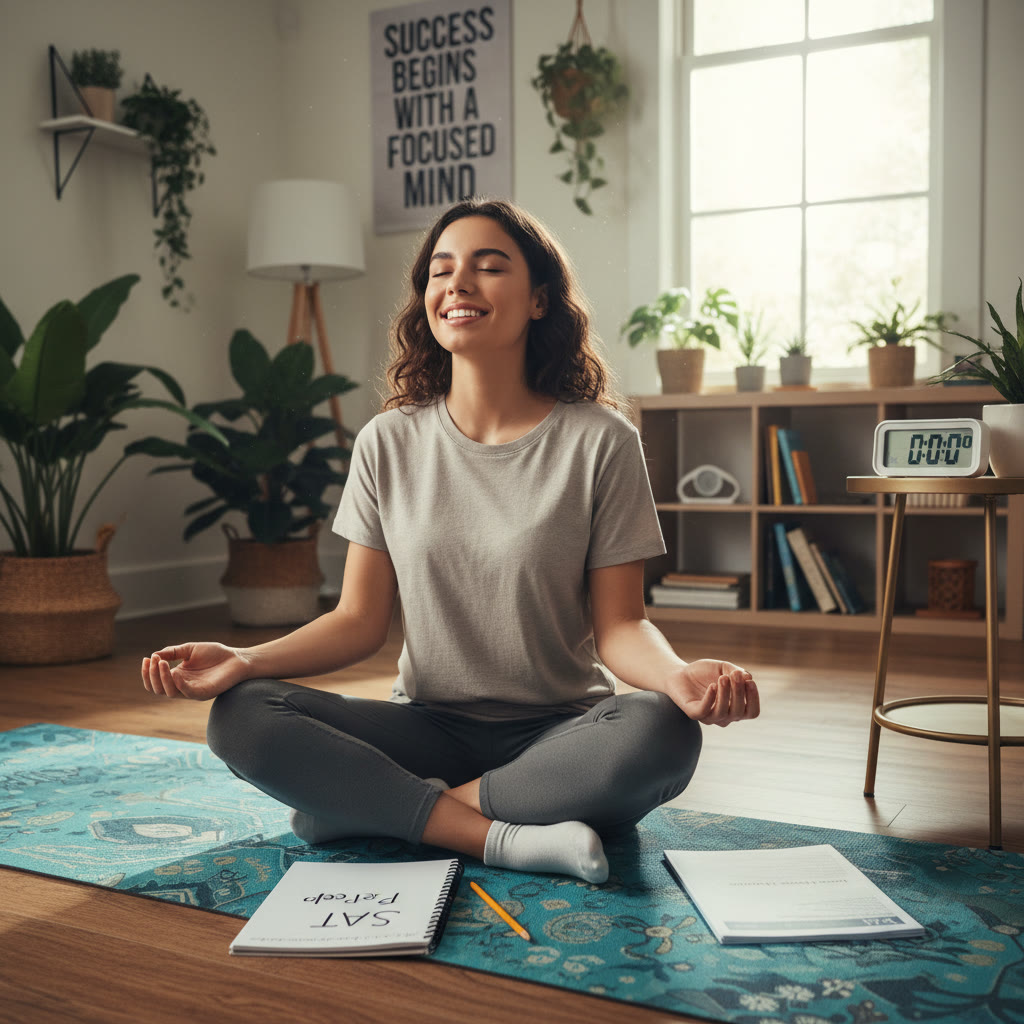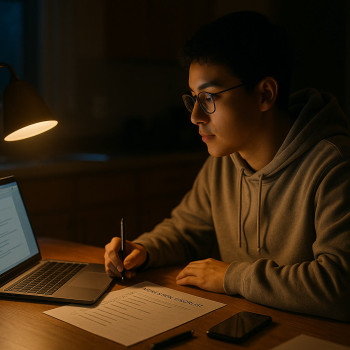Why Yoga Belongs in Your SAT Prep Toolbox
Studying for the SAT often feels like a sprint wrapped inside a marathon: long study sessions, high expectations, and that humming background anxiety that sneaks up before practice tests. Yoga doesn’t promise extra points—but what it does offer is something just as valuable: a calmer brain, steadier focus, and a body that actually helps you think clearly. Think of yoga as mental maintenance. When your nervous system is balanced, memory retrieval, problem solving, and reading comprehension all work better. It’s not magic; it’s physiology.
What yoga does for the brain and body
Here are practical, science-backed ways yoga helps during SAT prep:
- Reduces stress hormones (like cortisol) and activates the parasympathetic nervous system, which helps you relax and recover between study sessions.
- Improves breathing and oxygen flow—simple diaphragmatic breathing helps reduce heart rate and clear the mind before a test or practice question.
- Relieves muscle tension from long hours sitting and improves posture—more blood flow to the brain equals sharper thinking.
- Teaches attentional control and mindfulness—skills you can carry into test day to calm nerves and focus on the question at hand.
Small Practices, Big Returns: Quick Tools to Use Right Now
If you’re short on time—perfectly normal during the final sprint—these micro-practices can be woven into 5–10 minute breaks. They’re designed to reset your nervous system and sharpen attention so your next study block is more productive.
1. The 4-4-8 Breath (2 minutes)
How to do it: Inhale gently for 4 counts, hold for 4, exhale for 8. Repeat 6–8 times. This simple rhythm naturally slows heart rate and signals your brain that everything is safe, so concentration returns.
2. Neck and shoulder release (3 minutes)
How to do it: Sit tall. Drop your right ear toward your right shoulder and breathe into the left side of your neck. Roll gently. Do 5 slow breaths each side. Finish with shoulder rolls. Tension in the neck and shoulders is a classic sign of study strain—releasing it makes reading feel easier and less tiring.
3. Chair Cat-Cow (2 minutes)
How to do it: Sit on the edge of a chair. On the inhale, arch your spine and lift your chest (cow). On the exhale, round the spine and tuck the chin (cat). Repeat 8–10 times. This movement mobilizes your spine after long seated stretches and helps bring focused awareness back to the present.
Short Sequences to Fit Different Parts of Your Study Day
Different times of day call for different practices. Use energizing flows in the morning, grounding practices midday, and restorative work in the evening to maximize study efficiency and sleep quality.
Morning: Wake-Up Flow (10 minutes)
Goal: Increase alertness and blood flow so you can make the most of your morning study session.
- 5 Sun Salutation A (gentle and paced) or a shortened version: Tadasana (mountain) to Forward Fold to Halfway Lift to Downward Dog to Plank (optional) to Child’s Pose. Move with breath for 5–8 rounds.
- Warrior II (30 seconds per side) to build confidence and upright posture.
- Standing Forward Fold (uttanasana) for 5 deep breaths to calm the nervous system briefly before you sit down to study.
Midday Reset: Focus & Release (8 minutes)
Goal: Shake off mental fog after a long study block and return to work with clarity.
- Alternate Nostril Breathing (Nadi Shodhana) for 2–3 minutes—excellent for recalibrating attention.
- Cat-Cow on hands and knees, 10 rounds.
- Downward Dog to Knee-to-Nose (5 reps) to increase circulation.
- Seated twist for 30 seconds each side to relieve back tension and give a mini-reset.
Pre-Practice Test or Timed Section: Calm & Center (5 minutes)
Goal: Quiet the mind, slow the breath, reduce performance anxiety.
- Box breathing (4-4-4-4) three times.
- Seated Tadasana with grounding through the sit bones—visualize attention narrowing like a camera lens.
- Soft jaw and face release—clench gently then relax, then make small circular movements with the eyes to relieve eye strain.
Evening: Restore & Sleep Prep (15–20 minutes)
Goal: Help your nervous system wind down so you sleep well, which is essential for memory consolidation.
- Gentle forward folds and hip openers (pigeon or supine Figure-4) for 2–3 minutes each.
- Legs-Up-the-Wall (Viparita Karani) for 8–10 minutes—this restorative pose soothes the nervous system and reduces swelling from long sitting.
- Guided body-scan meditation lying down for 5–8 minutes to close the day and consolidate learning.

Pose Primer: Simple Postures and Why They Help
Here’s a compact table you can keep on your desk. Use it as a “quick reference” for which pose to pick depending on what you need.
| Pose | How Long | Main Benefit |
|---|---|---|
| Child’s Pose (Balasana) | 1–3 minutes | Calms the nervous system; gentle spinal stretch |
| Downward Dog (Adho Mukha Svanasana) | 1–2 minutes | Boosts circulation; energizing and lengthens the spine |
| Legs-Up-the-Wall (Viparita Karani) | 5–10 minutes | Restorative; reduces fatigue and anxiety |
| Seated Forward Fold | 1–3 minutes | Soothes the nervous system and encourages introspective focus |
| Warrior II (Virabhadrasana II) | 30–60 seconds per side | Builds confidence, improves posture and grounding |
| Alternate Nostril Breathing | 2–5 minutes | Balances left/right brain activity; calms anxiety |
Integrating Yoga with Your Study Plan: A Real-World Sample Week
Below is a flexible weekly template built for an average SAT student balancing school, studying, and rest. You can adapt it to a busier or lighter schedule. Short, consistent sessions beat occasional marathon yoga—consistency trains your nervous system.
| Day | Morning (10–15 min) | Afternoon/Study Breaks (5–10 min) | Evening (10–20 min) |
|---|---|---|---|
| Monday | Wake-Up Flow | Chair Cat-Cow + 4-4-8 breath between study blocks | Legs-Up-the-Wall + body scan |
| Tuesday | Gentle sun salutations | Alternate nostril breathing before timed practice | Seated forward fold + progressive muscle relaxation |
| Wednesday | Warrior II + standing poses | Neck/shoulder release and eye breaks | Restorative hip-openers |
| Thursday | Short vinyasa to energize | Box breathing before practice tests | Bedtime forward fold + short meditation |
| Friday | Dynamic stretches + sun salutations | Grounding twist and breathwork | Light restorative sequence |
| Saturday | Longer practice (20–30 min) — focus on mobility | Short walks and diaphragmatic breathing | Relaxation and sleep prep |
| Sunday | Rest or gentle stretching | Review materials lightly with micro-breaks | Legs-Up-the-Wall and journaling |
This schedule plays nicely with focused tutoring sessions. For example, when students use Sparkl’s personalized tutoring, tutors can suggest the best times for these micro-practices in a tailored study plan and coordinate short breathing techniques to do before mock sections—making each tutoring session more productive and less anxious for the student.
Mindful Techniques That Help on Test Day
Test day is the real stage. A few simple tools practiced ahead of time will become automatic when you need them most.
Arrival Routine (10–15 minutes before the test)
- Find a quiet corner. Do 1–2 minutes of box breathing (4-4-4-4).
- Practice a quick posture check—stand tall for 30 seconds like a mountain pose to open your chest and boost confidence.
- Use a short grounding technique: name five things you can see, four you can touch, three you can hear—this brings you fully into the present and away from ruminating thoughts.
During the Test: Calm Mind Tools
- Micro-breath resets: if you feel anxiety mid-section, exhale slowly for 8 counts, inhaling for 4. Even one slow exhale can slow a racing heart.
- Posture checks at every break—lift your sternum, press feet into the floor. Good posture supports steady breathing and clear thinking.
- Use the Pomodoro-inspired approach for long practice tests at home—study for 25–30 minutes, take a 5–10 minute yoga/breathing break, then return refreshed. This conditions your brain for spaced focus sessions similar to test timing.
Practical Tips & Troubleshooting
Yoga should feel helpful, not stressful. If you’re new, follow these safety and consistency pointers.
- Start small. Choose 2–3 practices and do them consistently for 2–3 weeks before adding more.
- Focus on breath. Even simple seated breathing has outsized benefits compared with complex sequences done inconsistently.
- Avoid overexertion. Yoga for SAT prep is about nervous system regulation—intensity is less important than stillness and rhythm.
- Modify poses. If you have tight hips or other physical limitations, use props (a cushion or folded blanket) and shorten hold times.
How to Blend Yoga with Tutoring and Study Tools
Yoga shines brightest when it’s part of a thoughtfully constructed study plan. If you’re working with a tutor—especially through a program like Sparkl’s personalized tutoring—bring your yoga routine into the conversation. Tutors can help:
- Align breath and short yoga resets to the most stressful parts of practice tests (e.g., time-pressured math sections).
- Craft study blocks that end with a calming practice, improving retention and lowering test-day anxiety.
- Use Sparkl’s 1-on-1 guidance and expert tutors to tailor recommendations—an individualized plan that includes when to practice yoga, which mindfulness techniques match your stress patterns, and how AI-driven insights can suggest ideal break timing based on your real performance data.
Real Student Example: How One Routine Changed Focus
Anna, a high school senior juggling AP classes and SAT prep, used to cram 3–4 hour sessions and feel exhausted and forgetful. She started adding three small habits: a 3-minute box breathing exercise before each study block, a 5-minute mid-study chair sequence, and Legs-Up-the-Wall before sleep. Within two weeks she reported fewer headaches, improved recall on practice readings, and steadier timing on math sections. With Sparkl’s personalized tutoring, her tutor suggested exact moments in her study plan to place these breaks, tailored to when she typically hit mental fog. The result was not overnight miracles, but steady, reliable improvements in focus.
Common Questions Students Ask
Will yoga make me less focused because I’ll be too relaxed?
Not at all—relaxation and focus are not opposites. Think of relaxation as clearing the debris from your desk so the important papers are visible. Yoga reduces the background noise so directed attention can work efficiently.
How long until I notice benefits?
Some benefits (calm after a breathing exercise) are immediate. Others—like better sleep and improved memory consolidation—typically emerge after 2–4 weeks of consistent practice.
Can I do yoga in a small space or at school?
Yes. Many practices are chair-friendly or require only a small area for standing. Alternate nostril breathing, box breathing, and posture checks are completely discreet and school-appropriate.
Final Notes: Yoga as a Study Habit, Not a Chore
A successful SAT prep strategy blends hard work with smart recovery. Yoga is one of the simplest, most portable ways to get high-quality recovery: it requires no fancy equipment, fits into short breaks, and helps build mental habits that transfer directly to test performance—steady breathing, clearer attention, and better posture. When these small things work together, your practice tests become more accurate reflections of your ability, and test day becomes less about panic and more about performance.
And remember: if personalized guidance feels helpful, coaches at Sparkl can integrate yoga and mindfulness into your tailored study plan—pairing 1-on-1 tutoring with targeted relaxation methods and even AI-driven insights that recommend the best timing for breaks based on how you perform in practice. It’s not a one-size-fits-all cure, but for many students, the combination of focused study and calm, repeatable recovery is exactly what leads to steady score improvement.

Start small. Breathe intentionally. Move often. Your brain will thank you on the day the scores come back.















No Comments
Leave a comment Cancel